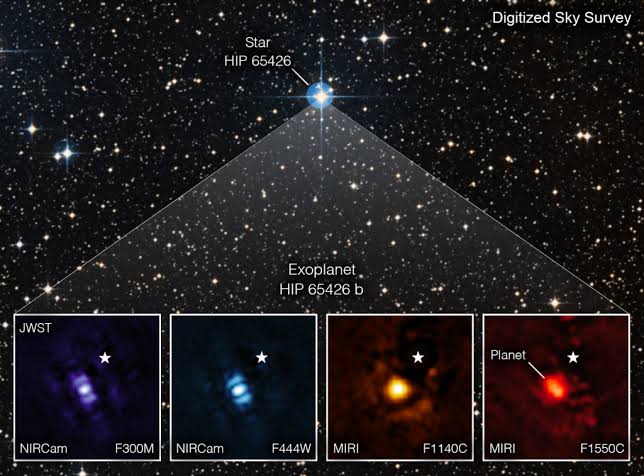According to NASA’s Goddard Space Flight Center’s Christopher Stark, the James Webb Space Telescope is essential to the research of exoplanets. The exoplanet atmospheres’ chemical compositions may be measured by its sophisticated instrumentation, revealing details about their circumstances and possible habitability. Researchers anticipate finding additional exoplanets and learning more about the cosmos through these surveys.
James Webb and Search of Exoplanets:
The James Webb Space Telescope, which has a variety of viewing modes that enable it to directly discover some of these far-off worlds, is a game-changer in the study of exoplanets.
But finding these planets is not an easy feat. The planets of even the nearest stars are so far away that they appear as tiny dots separated by a distance hardly larger than the width of a hair held at arm’s length.
Discovering the flimsy light emitted by these exoplanets at such minute angular scales is like discovering a needle in a haystack. This already weak light is further obscured by the overpowering glare of its host star, making observation practically impossible.
The James Webb Space Telescope accomplishes the seemingly impossible by using its cutting-edge technology to block out the glaring light from their star and simultaneously collect the ethereal light from these far-off planets.
This discovery gives scientists fresh information on the make-up, atmosphere, and possible habitability of exoplanets, providing a window into the enigmatic nature of our universe.
JWST’s Incredible Technology:
The James Webb Space Telescope’s cutting-edge Near-Infrared Camera (NIRCam) and Mid-Infrared Instrument (MIRI) coronagraphic modes help it overcome the tremendous hurdle of directly discovering exoplanets.
These specialised devices efficiently shield the telescope’s sensors from the glaring light of far-off stars while allowing the planet’s weak light to shine through. This is comparable to how we cover our car’s visor to protect our eyes from the sun’s glare at sunrise or dusk.
Webb can use this state-of-the-art equipment to catch the elusive light emitted by these distant worlds and gain insightful knowledge about their properties and potential habitability. The coronagraphs, a more advanced version of our vehicle visor, allow us to detect exoplanets and therefore unlock the secrets of the cosmos.
The “image plane” and “pupil plane,” which are used by the telescope’s coronagraphs to filter out undesired starlight, are just two of the important “planes” that make up Webb’s optics. In contrast to picture plane masks, which filter starlight, MIRI’s “four-quadrant phase masks” cancel out light waves using destructive interference. The pupil plane masks (Lyot stops) are employed to filter out the remaining starlight because the image plane masks are unable to completely obscure the star. Images lacking Webb’s typical diffraction pattern are the outcome of this.

With a combined total of nine coronagraphic masks, Webb’s NIRCam and MIRI instruments can observe exoplanets at various wavelengths and at distances ranging from a few to hundreds of Astronomical Units from the host star.
However, a small amount of the star’s light can still pass through these masks. In order to acquire a clearer view of the dim exoplanet, Webb’s astronomers use point spread function (PSF) subtraction techniques. A noisy pattern is produced as a result of this process, and it is this pattern’s ability to distinguish between the star’s and the exoplanet’s faintness defines the contrast. Webb’s coronagraphs impressed observers with outstanding contrasts of 10-5 and 10-4 at 1 arcsecond separation for NIRCam and MIRI, respectively, during commissioning.

The Opportunities for Us:
Webb’s sophisticated coronagraphic capabilities make it the perfect tool for examining dim infrared objects, enhancing existing observations by other instruments at different wavelengths. Its coronagraphs will be utilised to image dense circumstellar and protoplanetary discs as well as detect large extrasolar planets that are still warm from formation.
They can be used to examine host galaxies that have luminous active galactic nuclei in extragalactic astronomy. Astronomers will learn more about the universe surrounding us and the mysteries of exoplanets thanks to Webb’s coronagraphs.
Conclusion:
Although Webb’s coronagraphs are effective research tools for exoplanets, there is still much to learn about the enormous cosmos. We will require far more advanced coronagraphs that can identify planets one ten billionth the brightness of the star in order to find Earth-like planets orbiting neighbouring stars. New coronagraph technology will be tested by NASA’s Nancy Grace Roman Space Telescope, and the organisation is also laying the framework for a potential Habitable Worlds Observatory mission concept.
This future telescope would be as big as Webb, work at Hubble’s wavelengths, and be made especially for finding Earth-like exoplanets and looking for life there. Science and technology are being pushed to their limits in the ongoing quest for extraterrestrial life and new worlds.
